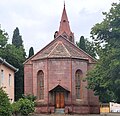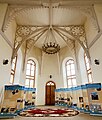Church in Azerbaijan
| St. John's Church | |
|---|---|
| |
 Clocktower of the former church, now museum, in 2022 Clocktower of the former church, now museum, in 2022 | |
| 40°35′13″N 46°18′57″E / 40.58694°N 46.31583°E / 40.58694; 46.31583 | |
| Address | Goygol, Goygol District |
| Country | Azerbaijan |
| Denomination | German Lutheran Church (former) |
| History | |
| Status |
|
| Consecrated | 1857 |
| Architecture | |
| Functional status |
|
| Style | Gothic Revival |
| Groundbreaking | 1854 |
| Completed | 1857 |
| Specifications | |
| Length | 36.6 m (120 ft) |
| Width | 13.3 m (44 ft) |
| Number of spires | One |
The Saint John's Church (Azerbaijani: Müqəddəs İohann kilsəsi; German: St. Johanniskirche) is a former Lutheran church in Goygol (formerly known as Helenendorf and later Khanlar), Azerbaijan. Completed in 1857, it was the first German Lutheran church built in Azerbaijan.
The church was included on the list of immovable historical and cultural monuments of local importance by decision No. 132 issued by the Cabinet of Ministers of the Republic of Azerbaijan on August 2, 2001, soon after Azerbaijan restored its independence.
The former church building currently houses the Goygol Museum of History and Ethnography.
History
In 1817, several hundred families of Swabian Lutheran pietists arrived in Russian Empire with the permission of Emperor Alexander I. Nearly 700 of them were resettled in Transcaucasia, where as many as 120 of them founded the colony of Helenendorf. After the colony was established, a Lutheran congregation was officially established. The first religious rituals were held by teachers of the parish school until a priest from Hanover was invited in 1832 to run the congregation.

Over time, the need for a place of worship became apparent. The cornerstone for the church was laid next to the parish school on 24 April 1854. The Gothic Revival church, constructed over three years and consecrated as St. John's Church, became the first Lutheran church building in Azerbaijan. Its first appointed pastor was Georg Heinrich Reitenbach. The church organ was manufactured by E. F. Walcker & Cie., a Ludwigsburg-based company. The building, constructed from red brick, has a single clock tower, 16 large and two small windows, all crafted from wood, and two entrance doors. The church measures 13.3 m (44 ft) in width, 36.6 m (120 ft) in length, and has a ceiling height of 8.6 m (28 ft).
During the Soviet era
In 1928, eight years after the Sovietisation of Azerbaijan, the Soviet government launched an anti-religious campaign. Between 1936 and 1938, all Azerbaijani Lutheran pastors were arrested. The last priest of Helenendorf's St. John's Church, Reverend Otto Wenzel, was arrested for the first time in 1931. He was liberated shortly afterwards and continue to exercise his duties until 1936. The last confirmation ceremony at St. Jonh's Churchtook place in the church in 1934 and was attended by 85 teenagers. In 1936, Wenzel was arrested a second time and freed in 1939, only to be arrested again later that year. After his arrest, the church bell and the organ were removed from the church. The church building was locked down after the central government in Moscow ordered for all citizens of German origin to be deported from Azerbaijan and Georgia in 1941–1942, following the German army's offensive towards the Caucasus during World War II. At different times, the building served as an indoor arena and a military hospital.
After independence
The church was included on the list of immovable historical and cultural monuments of local importance by decision No. 132 issued by the Cabinet of Ministers of the Republic of Azerbaijan on August 2, 2001, just after the Azerbaijan Republic restored its independence.
Since 2005, the church houses the Goygol Museum of History and Ethnography.
In 2008, St. John's Church underwent renovatation with the financial support of the German Development Cooperation. The tower was supplied with a clock and bells thanks to fundraising efforts of EuroKaukAsia, a German society for culture and science.
Gallery
See also
References
- ^ Sudaba, Zeynalova (January 1, 2005). "Germans in Azerbaijan: a retrospective analysis". Central Asia and the Caucasus (6). ISSN 1404-6091. Archived from the original on November 22, 2023. Retrieved November 22, 2023.
- ^ Zeynalova, Südabə (2016). Azərbaycanda alman məskənlərinin salınmasından 200 il keçir (in Azerbaijani). Bakı: Xalq qəzeti.
- Əliyev, Elçin (2017). Deutschs Erbe Spuren in der Architektur von Aserbaidschan (PDF) (in German). Bakı: Botschaft der Bundesrepublik Deutschland Baku. p. 42. Archived (PDF) from the original on April 28, 2021. Retrieved November 29, 2023.
- Hacıyeva, Rima (2019). Azərbaycan tolerantlığında alman irsinin izləri və memarlığı (in Azerbaijani). Bakı: Mənəvi Dəyərlərin Təbliği Fondu. p. 156.
- ^ ""Lüteran kilsəsi"". irs.gov.az. Archived from the original on November 22, 2023. Retrieved November 22, 2023.
- Hacıyeva, Rima (2019). Azərbaycan tolerantlığında alman irsinin izləri və memarlığı (in Azerbaijani). Bakı: Mənəvi Dəyərlərin Təbliği Fondu. p. 43.
- "Helenendorf/Göygöl/Chanlar". ome-lexikon.uni-oldenburg.de. Archived from the original on March 28, 2023. Retrieved November 28, 2023.
- "Göygöl şəhərində almanların izi ilə | Azerbaijan.Travel". azerbaijan.travel (in Azerbaijani). Archived from the original on March 23, 2023. Retrieved November 28, 2023.
- "Über 300 deutsche Häuser stehen in Göygöl noch". Azerbaijan State News Agency. July 29, 2019. Archived from the original on July 31, 2019. Retrieved November 28, 2023.
- "Deutsche in Aserbaidschan". Deutsche Volksgruppen (in German). July 5, 2020. Archived from the original on September 25, 2023. Retrieved November 28, 2023.
- Sudaba, Zeinalova (January 1, 2007). "The Evangelical-Lutheran community in Azerbaijan: a retrospective analysis". The Caucasus & Globalization. 1 (5). ISSN 1819-7353. Archived from the original on August 15, 2016. Retrieved June 25, 2016.
- ^ Köhnəqala, Murad; Göytürk, Şəlalə (August 11, 2017). "Армяне разграбили немецкую церковь – РЕПОРТАЖ (часть III)". vzglyad.az (in Russian). Retrieved November 28, 2023.
- Arif Yunusov (2004). Ислам в Азербайджане (PDF). Bakı: Zaman. p. 78. ISBN 9952-8052-0-9. Archived (PDF) from the original on July 5, 2023. Retrieved December 30, 2022.
- Hacıyeva, Rima (2019). Azərbaycan tolerantlığında alman irsinin izləri və memarlığı (in Azerbaijani). Bakı: Mənəvi Dəyərlərin Təbliği Fondu. p. 151. Archived from the original on February 6, 2024. Retrieved January 8, 2024.
- ^ Zeynalova, Südabə (2014). Лютеране в России. Сборник докладов Международной научной конференции (Омск, 9–10 октября 2014 г.) / К истории возникновения евангелическо-лютеранской общины в Азербайджане (XIX – начало XX вв.) (in Russian). Omsk: Ииздательство ОмГТУ. p. 94. Archived from the original on December 24, 2022. Retrieved November 28, 2023.
- ^ "Лютеранская кирха в азербайджанском Гёйгёле стала символом уважения к разным культурам". vestikavkaza.ru (in Russian). November 25, 2020. Archived from the original on January 20, 2021. Retrieved November 28, 2023.
- "Azərbaycan Respublikası Nazirlər Kabinetinin 2001-ci il 2 avqust Tarixli 132 nömrəli qərarı ilə təsdiq edilmişdir" (PDF) (in Azerbaijani). mct.gov.az. August 2, 2001. Archived from the original (PDF) on July 7, 2021. Retrieved November 2, 2023.
- "Göygölün tarixi rəmzi olan Lüteran kilsəsi - VİDEO". Oxu.Az (in Azerbaijani). December 8, 2022. Archived from the original on December 14, 2022. Retrieved November 28, 2023.
- Əliyev, Elçin (2017). Deutschs Erbe Spuren in der Architektur von Aserbaidschan (PDF) (in German). Bakı: Botschaft der Bundesrepublik Deutschland Baku. p. 45. Archived (PDF) from the original on April 28, 2021. Retrieved November 29, 2023.




